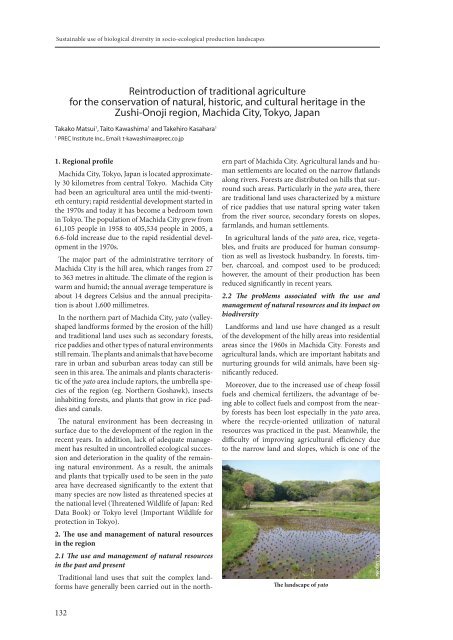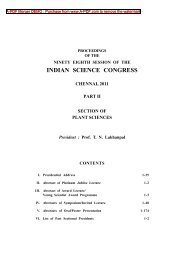sustainable use of biological diversity.pdf - India Environment Portal
sustainable use of biological diversity.pdf - India Environment Portal
sustainable use of biological diversity.pdf - India Environment Portal
Create successful ePaper yourself
Turn your PDF publications into a flip-book with our unique Google optimized e-Paper software.
Sustainable <strong>use</strong> <strong>of</strong> <strong>biological</strong> <strong>diversity</strong> in socio-ecological production landscapes<br />
Reintroduction <strong>of</strong> traditional agriculture<br />
for the conservation <strong>of</strong> natural, historic, and cultural heritage in the<br />
Zushi-Onoji region, Machida City, Tokyo, Japan<br />
Takako Matsui 1 , Taito Kawashima 1 and Takehiro Kasahara 1<br />
1<br />
PREC Institute Inc., Email: t-kawashima@prec.co.jp<br />
1. regional pr<strong>of</strong>ile<br />
Machida City, Tokyo, Japan is located approximately<br />
30 kilometres from central Tokyo. Machida City<br />
had been an agricultural area until the mid-twentieth<br />
century; rapid residential development started in<br />
the 1970s and today it has become a bedroom town<br />
in Tokyo. The population <strong>of</strong> Machida City grew from<br />
61,105 people in 1958 to 405,534 people in 2005, a<br />
6.6-fold increase due to the rapid residential development<br />
in the 1970s.<br />
The major part <strong>of</strong> the administrative territory <strong>of</strong><br />
Machida City is the hill area, which ranges from 27<br />
to 363 metres in altitude. The climate <strong>of</strong> the region is<br />
warm and humid; the annual average temperature is<br />
about 14 degrees Celsius and the annual precipitation<br />
is about 1,600 millimetres.<br />
In the northern part <strong>of</strong> Machida City, yato (valleyshaped<br />
landforms formed by the erosion <strong>of</strong> the hill)<br />
and traditional land <strong>use</strong>s such as secondary forests,<br />
rice paddies and other types <strong>of</strong> natural environments<br />
still remain. The plants and animals that have become<br />
rare in urban and suburban areas today can still be<br />
seen in this area. The animals and plants characteristic<br />
<strong>of</strong> the yato area include raptors, the umbrella species<br />
<strong>of</strong> the region (eg. Northern Goshawk), insects<br />
inhabiting forests, and plants that grow in rice paddies<br />
and canals.<br />
The natural environment has been decreasing in<br />
surface due to the development <strong>of</strong> the region in the<br />
recent years. In addition, lack <strong>of</strong> adequate management<br />
has resulted in uncontrolled ecological succession<br />
and deterioration in the quality <strong>of</strong> the remaining<br />
natural environment. As a result, the animals<br />
and plants that typically <strong>use</strong>d to be seen in the yato<br />
area have decreased significantly to the extent that<br />
many species are now listed as threatened species at<br />
the national level (Threatened Wildlife <strong>of</strong> Japan: Red<br />
Data Book) or Tokyo level (Important Wildlife for<br />
protection in Tokyo).<br />
2. The <strong>use</strong> and management <strong>of</strong> natural resources<br />
in the region<br />
2.1 The <strong>use</strong> and management <strong>of</strong> natural resources<br />
in the past and present<br />
Traditional land <strong>use</strong>s that suit the complex landforms<br />
have generally been carried out in the northern<br />
part <strong>of</strong> Machida City. Agricultural lands and human<br />
settlements are located on the narrow flatlands<br />
along rivers. Forests are distributed on hills that surround<br />
such areas. Particularly in the yato area, there<br />
are traditional land <strong>use</strong>s characterized by a mixture<br />
<strong>of</strong> rice paddies that <strong>use</strong> natural spring water taken<br />
from the river source, secondary forests on slopes,<br />
farmlands, and human settlements.<br />
In agricultural lands <strong>of</strong> the yato area, rice, vegetables,<br />
and fruits are produced for human consumption<br />
as well as livestock husbandry. In forests, timber,<br />
charcoal, and compost <strong>use</strong>d to be produced;<br />
however, the amount <strong>of</strong> their production has been<br />
reduced significantly in recent years.<br />
2.2 The problems associated with the <strong>use</strong> and<br />
management <strong>of</strong> natural resources and its impact on<br />
bio<strong>diversity</strong><br />
Landforms and land <strong>use</strong> have changed as a result<br />
<strong>of</strong> the development <strong>of</strong> the hilly areas into residential<br />
areas since the 1960s in Machida City. Forests and<br />
agricultural lands, which are important habitats and<br />
nurturing grounds for wild animals, have been significantly<br />
reduced.<br />
Moreover, due to the increased <strong>use</strong> <strong>of</strong> cheap fossil<br />
fuels and chemical fertilizers, the advantage <strong>of</strong> being<br />
able to collect fuels and compost from the nearby<br />
forests has been lost especially in the yato area,<br />
where the recycle-oriented utilization <strong>of</strong> natural<br />
resources was practiced in the past. Meanwhile, the<br />
difficulty <strong>of</strong> improving agricultural efficiency due<br />
to the narrow land and slopes, which is one <strong>of</strong> the<br />
The landscape <strong>of</strong> yato<br />
© K. Tagoku<br />
132
















